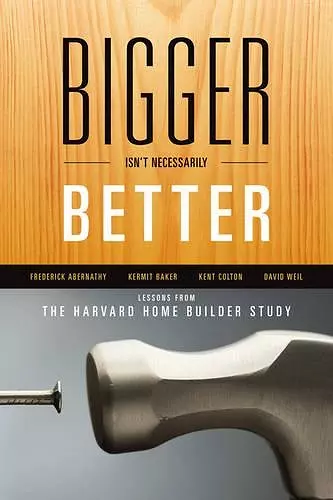Bigger Isn't Necessarily Better
Lessons from the Harvard Home Builder Study
Frederick Abernathy author Kermit Baker author Kent Colton author David Weil author
Format:Paperback
Publisher:Lexington Books
Published:30th Nov '11
Currently unavailable, and unfortunately no date known when it will be back

Despite the growth of huge national home builders and industry consolidation that accompanied it, Bigger Isn’t Necessarily Better shows that most builders did not improve their operational performance during the boom. As a result, the sector had a long way to fall as the economy collapsed about them. Given the importance of housing to the US economy, the book’s lessons are critical to those in homebuilding as well as to policy makers, scholars, and the public.
In these challenging times, in order to be successful, a home builder needs to excel at land assembly, marketing, on-site operations and customer satisfaction. The Harvard home builder study lays out very clearly what national builders have done well, and where they could benefit from improvements. This book provides a roadmap to improve competitiveness in today’s demanding economic environment while increasing productivity as the market recovers. -- Dan Fulton, President and CEO of Weyerhaeuser Company
This book is filled with descriptive institutional detail and analytical insight. It looks at the industry from a range of perspectives, and it is ultimately positive in its outlook. It is hard to find this kind of balance today. -- Karl E. Case, Professor of Economics Emeritus at Wellesley College
The implosion in home building is a wakeup call to modernize this important industry. The authors make a persuasive case that home builders have much to learn from other industries that have successfully balanced innovation and scale leading to greater efficiencies. -- Nicolas P. Retsinas, Senior Lecturer in Real Estate at the Harvard Business School and former Assistant Secretary for Housing-Federal Housing Commissioner at the United States Department of Housing and Urban Development
Scale offers significant opportunities in the homebuilding business. However, as in any business, execution is the key. Bigger Isn't Necessarily Better provides a thorough analysis of where home builders have been able to leverage their competitive advantages, where they have not, and therefore how they can become more efficient as market conditions dictate. This is a landmark study of the industry on an important topic. -- Eric S. Belsky, Managing Director of the Joint Center for Housing Studies of Harvard University
Bigger Isn’t Necessarily Better: Lessons Learned from the Harvard Home Builder Study analyzes the eponymous study of the practices of big (more than 50,000 houses/year) home builders that came into being through consolidation and acquisition of smaller companies....As the book cover illustrates, the authors hit the nail on the head with their analysis. The study and its presentation flow nicely and avoid the propensity of this type of tome to sink into the gravity of its material. The authors deliver on the promise in their book’s title: through a lucid, well-ordered presentation of graphics and prose, they discern, explain, and share the lessons learned from the workings of the large home builders during of the last housing boom. Now it’s our turn—to study and apply these lessons so that we can do our share within the building industry to contribute to softer landings for all during future market downturns. * ReadInform.com *
Today I had the chance to sit in on a conference call with the authors of Bigger Isn't Necessarily Better (Lexington Books, November 30, 2011) a book based on the Harvard Builder Study comparing the performance and operations of mid- to large US homebuilders during the great building boom of the early 2000s. The book examines the operational side of the industry instead of financial performance, and provides a revealing look at how little progress mid- to large homebuilders made in improving their jobsite coordination and control, despite the rise of hugely profitable national companies, the kind you would expect to implement the most advanced operational systems, like automakers and large retailers have. To facilitate useful comparisons the authors narrowed their analysis to entry-level home divisions, avoiding comparisons between various price points. * FineHomebuilding.com *
You can feel the touch of four different hands in the presentation of the material through nuances of style and emphasis. This is a good thing for this work, as the four different kinds of expertise are unified into one theory: it adds texture and personality to the narrative. The authors also offer a generous spread of graphic materials to help the reader grasp the large amount of data presented in the book. ... As the book cover illustrates, the authors hit the nail on the head with their analysis. The study and its presentation flow nicely and avoid the propensity of this type of tome to sink into the gravity of its material. The authors deliver on the promise in their book’s title: through a lucid, well-ordered presentation of graphics and prose, they discern, explain, and share the lessons learned from the workings of the large home builders during of the last housing boom. Now it’s our turn—to study and apply these lessons so that we can do our share within the building industry to contribute to softer landings for all during future market downturns. * Inform *
Explores industry trends in residential construction during the late 1990s and early 2000s and their relationship to the housing boom and bust, based on data from the Harvard Home Builder Survey. * Journal of Economic Literature *
ISBN: 9780739172896
Dimensions: unknown
Weight: unknown
138 pages